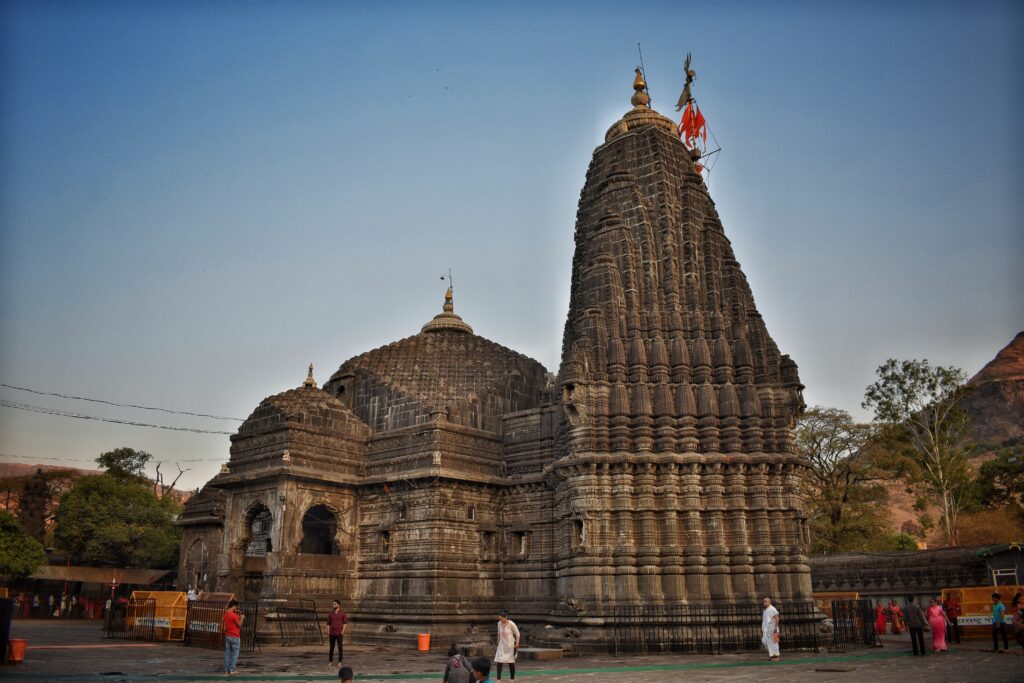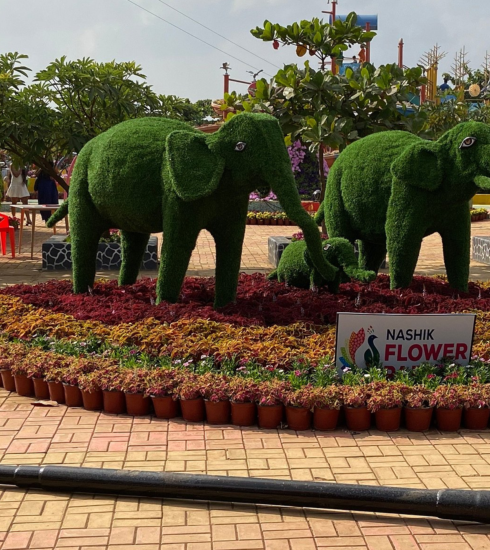Trimbakeshwar Temple: Where Spiritual Serenity Meets Divinity
One of India’s twelve Jyotirlingas is the Trimbakeshwar Temple. This Shaiva temple has been found near Trimbak, which is 28 kilometres from Nashik City, at the base of the Brahmagiri Hills. The temple, built in the 18th century by the Maratha king Peshwa Nana Saheb, is mentioned in the powerful Mrityunjaya Mantra, which bestows immortality and longevity.
The temple’s grounds, which feature classic architecture, also mention the Kushavarta or Kunda, which is thought to be the river Godavari’s source. The Jyotirlingas’ three faces, which stand for Lord Brahma, Lord Vishnu, and Lord Rudra, are an inspiring feature. The ‘garbhagriha’, or central portion, of the temple is restricted to male devotees.

Pooja and rituals at the Trimbakeshwar Temple
The place is well-known for its extensive religious rituals (vidhis). This is where Narayan Nagbali, Kalsarpa Shanti, and Tripindi Vidhis are done. Only Trimbakeshwar does the Narayan Nagbali puja. Three days are needed to complete this pooja. This puja is carried out on particular days. This puja should not be performed on certain days. This puja is performed for a variety of causes, including financial difficulties, childless couples, illness, terrible times, killing a cobra (Nag), and desire to perform a religious puja in order to have everything.

Architecture of the Trimbakeshwar Temple
The temple is situated between Brahmagiri, Nilagiri, and Kalagiri, three hills. The three lingas in the temple stand for Shiva, Vishnu, and Brahma. Amritavarshini is the name of the temple tank, which is 28 metres (92 feet) by 30 metres (98 feet) in size. Bilva Tirtha, Viswanantirtha, and Mukundatirtha are the names of three other bodies of water. Lords including Ganga, Jaleswara, Rameswara, Gautameswara, Kedarnatha, Rama, Krishna, Parashurama, and Lakshmi Narayana are all represented through images. The temple also contains a number of monasteries and saints’ Samadhis.

Temple History
The Legend of Gautam Rishi and Lord Shiva
Trimbak, thought to be the birthplace of mystics or rishis, is also thought to have been the place where Gautam Rishi and his wife Ahilya lived. When the area experienced a severe drought, the mystic fascinated Lord Varuna, the god of the waters, for mercy and to provide water to replenish the land’s water supplies. Lord Varuna granted Trimbak a plentiful supply of water in response to his requests.
Due to this incident, many other mystics became envious of Gautam Rishi. As a result, the former begged Lord Ganesha to send a cow to destroy Gautam Rishi’s richly planted field of crops, which suddenly dried up. Gautam Rishi begged Lord Shiva forgiving him, fearing that he was responsible for the innocent cow’s death.
As a result of their prayers, Lord Shiva gave the order for the Ganga, which originated on Brahmagiri Hill, to flow down to the earth. Some of the Ganga’s precious waters were preserved by Gautam Rishi in a container known as the Kushavarta Kund, which is now acknowledged as a sacred bath. Gautam Rishi then asked Lord Shiva to live among them as compensation. Lord Shiva granted his wish and appeared as a Linga to reside there.
Finding the Edge of the Infinite Pillar of Light
Another legend states that Lord Shiva set up a protracted search for Lord Brahma and Lord Vishnu to locate the opposite end of the pillar of light Shiva had raised. Brahma made up the fact that he had discovered it, which was actually an endless column of fire with Shiva waiting on the other side. After realising Brahma was lying, Lord Shiva cursed him with never being beloved or revered. This angered Brahma, who then cursed Lord Shiva once more. Shiva hid underground at Trimbakeshwar, where a lingam is still visible, to defend himself.
Festivals at Temple
Kumbh Mela
One of the biggest religious gatherings in the world is the Kumbh Mela. Millions of pilgrims come to this festival, which is held only every 12 years, to take a holy dip in the Godavari. 2015 marked the most recent Kumbh Mela.
Mahashivaratri
Mahashivratri, which is celebrated in February or March, is regarded as a significant occasion because, according to believers, it was on this night that Lord Shiva and Goddess Parvati made their sacred wedding bond. Devotees continue the ritual even today by fasting and singing praises all day and all night.
Tripuri Purnima
Tripuri Purnima, also known as Karthika Purnima, occurs in November or December, which Hindu devotees regard as Karthika’s season. It is also referred to as the Festival of the Gods’ Lights. The victory of Lord Shiva over the demon Tripurasura and his three towns is the basis for this celebration, according to tradition.
Rath Poornima.
The Panchamukhi Idol of Lord Trimbakeshwar, or the five-faced idol, is paraded through the town during the festival of Rath Poornima, which takes place in January or February. The locals call this chariot a rath.










